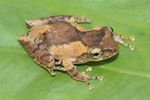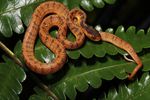Ghostly monkey, succulent bamboo among new species in Mekong
←
→
Page content transcription
If your browser does not render page correctly, please read the page content below
Ghostly monkey, succulent bamboo among
new species in Mekong
26 January 2022, by Elaine Kurtenbach
succulent bamboo species, found in Laos.
The Mekong region is a biodiversity hotspot and
home to tigers, Asian elephants, saola—an
extremely rare animal also called the Asian unicorn
or spindlehorn—and thousands of other species.
Including this latest list, scientists have identified
more than 3,000 new species in the region since
1997, the WWF said.
Scientists used measurements and samples from
museum collections to compare and identify key
differences with features of the newly discovered
animals and plants, the report said.
In this undated photo, a Popa langur moves along a
forest floor. The Popa langur is among 224 new species
listed in the World Wildlife Fund's latest update on the
Mekong region. The conservation group's report
released Wednesday, Jan. 26, 2022, highlights the need
to protect the rich biodiversity and habitats in the region,
which includes Vietnam, Cambodia, Laos, Thailand and
Myanmar. Credit: World Wildlife Foundation via AP
A monkey with ghostly white circles around its
eyes is among 224 new species listed in the World
Wildlife Fund's latest update on the greater
Mekong region.
The conservation group's report, released
Wednesday, highlights the need to protect the rich In this undated photo, a Doi Phu Kha newt sits on a
biodiversity and habitats in the region, which branch. The Doi Phu Kha newt is among 224 new
includes Vietnam, Cambodia, Laos, Thailand and species listed in the World Wildlife Fund's latest update
on the Mekong region. The conservation group's report
Myanmar.
released Wednesday, Jan. 26, 2022, highlights the need
to protect the rich biodiversity and habitats in the region,
The species listed were found in 2020 but last which includes Vietnam, Cambodia, Laos, Thailand and
year's report was delayed. The monkey is called Myanmar. Credit: World Wildlife Foundation via AP
the Popa langur, for it lives on the steep hillsides of
the extinct Mt. Popa volcano in Myanmar. It was
the only new mammal. There are also dozens of
newly identified reptiles, frogs and newts, fish and Studying such differences can help determine the
155 plant species, including the only known range of species and threats to their survival,
1/4Thomas Ziegler, a curator at the University of camera traps in 2018. FFI reported the discovery
Cologne's Institute of Zoology, said in introducing late last year.
the report.
The monkey is a candidate to be listed as a
Identifying new species is tricky, though, and critically endangered species on the Red List of the
sometimes can only be determined using a variety International Union for the Conservation of Nature,
of methods, such as frog calls and genetic data the report said, since only 200-250 are thought to
used to distinguish the Cardamom leaf little frog, survive in the wild, in a handful of places.
found high up in the Cardamom mountains in a
wildlife refuge. Underscoring the urgency of such work, more than
38,000 of the 138,000 species the IUCN tracks are
Some species are found in more than one country, threatened with extinction.
including the bright orange twin slug snake, which
consumes slugs. A new type of begonia with reddish flowers and a
berry-like fruit also was found in the uplands of
The Popa langur was identified based on genetic Myanmar, where illegal mining and logging have
matching of recently gathered bones with become an increasingly dire threat in the country,
specimens from Britain's Natural History Museum which is in the midst of political turmoil following a
collected more than a century ago, the report said. military takeover a year ago.
Two main distinguishing characteristics were the
broad white rings around its eyes and its front-
pointing whiskers.
In this undated photo, a twin slug snake rests on a leaf.
The twin slug snake is among 224 new species listed in
the World Wildlife Fund's latest update on the Mekong
In this undated photo, a frilled tree frog rests on a leaf. region. The conservation group's report released
The frilled tree frog is among 224 new species listed in Wednesday, Jan. 26, 2022, highlights the need to protect
the World Wildlife Fund's latest update on the Mekong the rich biodiversity and habitats in the region, which
region. The conservation group's report released includes Vietnam, Cambodia, Laos, Thailand and
Wednesday, Jan. 26, 2022, highlights the need to protect Myanmar. Credit: World Wildlife Foundation via AP
the rich biodiversity and habitats in the region, which
includes Vietnam, Cambodia, Laos, Thailand and
Myanmar. Credit: World Wildlife Foundation via AP
The WWF, working with Fauna and Flora
International, caught images of the monkeys using
2/4and other wild zones, much of the Greater Mekong
is still little explored and each year dozens of new
species are found—a glimmer of hope as so many
species go extinct.
Not all new species are found deep in jungles. One
of the new plant species is a ginger plant called
"stink bug" for its pungent odor similar to big
beetles Thais use to make a kind of chili dipping
paste served with rice, the report said.
It was found in northeastern Thailand, in a plant
shop.
More information: World Wildlife Fund:
In this undated photo, a Popa langur moves along a
https://www.worldwildlife.org/
forest floor. The Popa langur is among 224 new species
listed in the World Wildlife Fund's latest update on the
Mekong region. The conservation group's report released
Wednesday, Jan. 26, 2022, highlights the need to protect © 2022 The Associated Press. All rights reserved.
the rich biodiversity and habitats in the region, which This material may not be published, broadcast,
includes Vietnam, Cambodia, Laos, Thailand and rewritten or redistributed without permission.
Myanmar. Credit: World Wildlife Foundation via AP
In this undated photo, a Popa langur moves along a
forest floor. The Popa langur is among 224 new species
listed in the World Wildlife Fund's latest update on the
Mekong region. The conservation group's report released
Wednesday, Jan. 26, 2022, highlights the need to protect
the rich biodiversity and habitats in the region, which
includes Vietnam, Cambodia, Laos, Thailand and
Myanmar. Credit: World Wildlife Foundation via AP
Despite human encroachments on tropical forests
3/4APA citation: Ghostly monkey, succulent bamboo among new species in Mekong (2022, January 26)
retrieved 17 February 2022 from https://phys.org/news/2022-01-ghostly-monkey-mekong-region-
species.html
This document is subject to copyright. Apart from any fair dealing for the purpose of private study or research, no
part may be reproduced without the written permission. The content is provided for information purposes only.
4/4
Powered by TCPDF (www.tcpdf.org)You can also read
























































